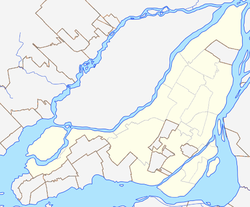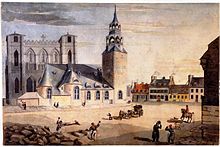
Paul de Chomedey, sieur de Maisonneuve was a French military officer and the founder of Fort Ville-Marie in New France.
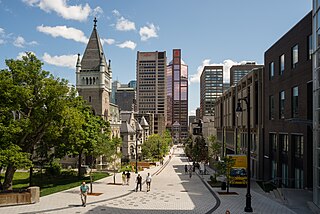
The architecture of Montreal, Quebec, Canada is characterized by the juxtaposition of the old and the new and a wide variety of architectural styles, the legacy of two successive colonizations by the French, the British, and the close presence of modern architecture to the south. Much like Quebec City, the city of Montreal had fortifications, but they were destroyed between 1804 and 1817.

Place-d'Armes station is a Montreal Metro station in the borough of Ville-Marie in Montreal, Quebec, Canada. It is operated by the Société de transport de Montréal (STM) and serves the Orange Line. It is located in Old Montreal.

Square-Victoria–OACI station is a Montreal Metro station in the borough of Ville-Marie in Montreal, Quebec, Canada. It is operated by the Société de transport de Montréal (STM) and serves the Orange Line. It is located in Victoria Square near the Quartier international de Montréal district. The station opened on February 6, 1967, four months after most of the initial network, and was briefly the terminus of the Orange Line until Bonaventure station was opened a week later.

Place-Saint-Henri station is a Montreal Metro station in the borough of Le Sud-Ouest in Montreal, Quebec, Canada. It is operated by the Société de transport de Montréal (STM) and serves the Orange Line. It is located in the Saint-Henri neighbourhood.

Ville-Marie is the name of a borough (arrondissement) in the centre of Montreal, Quebec. The borough is named after Fort Ville-Marie, the French settlement that would later become Montreal, which was located within the present-day borough. Old Montreal is a National Historic Site of Canada.
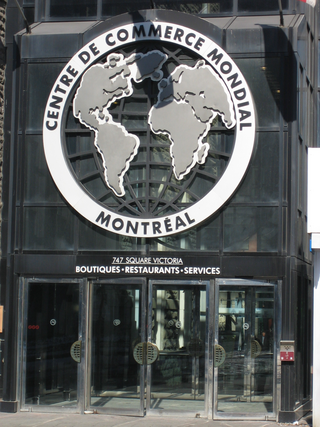
The Quartier international de Montréal (QIM) or Montreal's International District is a district of the Ville-Marie borough in the city's downtown core of Montreal, Quebec, Canada. It is roughly bordered by René-Levesque Boulevard to the north, Notre-Dame Street to the south, De Bleury/Saint-Pierre Street to the east and Robert-Bourassa Boulevard to the west. The Palais des congrès building lying just east of the district is also usually comprised in it. Constructed dispersedly between 1965 and 1985 in place of older colonial housing blocks, the district underwent major urban renewal as a central business district in 2000–2003.

Old Montreal is a historic neighbourhood within the municipality of Montreal in the province of Quebec, Canada. Home to the Old Port of Montreal, the neighbourhood is bordered on the west by McGill Street, on the north by Ruelle des Fortifications, on the east by rue Saint-André, and on the south by the Saint Lawrence River. Following recent amendments, the neighbourhood has expanded to include the Rue des Soeurs Grises in the west, Saint Antoine Street in the north, and Saint Hubert Street in the east.

Saint Jacques Street, or St. James Street, is a major street in Montreal, Quebec, Canada, running from Old Montreal westward to Lachine.
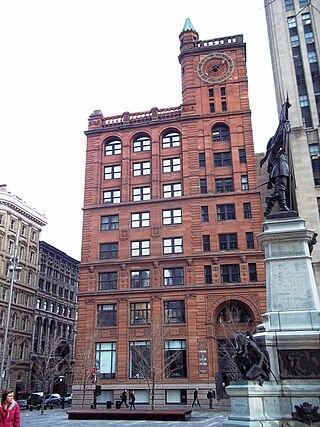
Montreal's New York Life Insurance Building is an office building at Place d'Armes in what is now known as Old Montreal, erected in 1887–1889. At the time of its completion, it was the tallest commercial building in Montreal with the first eight floors were designed for retail office space, that quickly filled with the city's best lawyers and financiers. When the clock tower was completed, the owner filled the ninth and tenth floors with the largest legal library in the entire country as a gift to tenants. The building is next to another historic office tower, Aldred Building.

The Saint-Sulpice Seminary is a building in Montreal, Quebec, Canada. It is the second oldest structure in Montreal and was declared a National Historic Site of Canada in 1980. It is located in the Ville-Marie Borough in the Old Montreal district, next to Notre-Dame Basilica on Notre-Dame Street, facing Place d'Armes. The seminary is a classic U-shaped building featuring a palatial style and includes an annex.
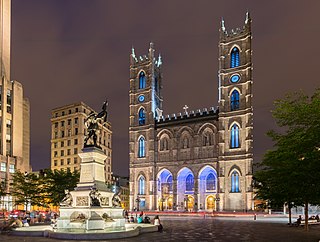
The Notre-Dame Basilica is a basilica in the historic district of Old Montreal, in Montreal, Quebec, Canada. The church is located at 110 Notre-Dame Street West, at the corner of Saint Sulpice Street. It is located next to the Saint-Sulpice Seminary and faces the Place d'Armes square.

The Aldred Building is an Art deco building on the historic Place d'Armes square in the Old Montreal quarter of Montreal, Quebec, Canada.
The timeline of Montreal history is a chronology of significant events in the history of Montreal, Canada's second-most populated city, with about 3.5 million residents in 2018, and the fourth-largest French-speaking city in the world.

The Société Notre-Dame de Montréal, otherwise known as the Société de Notre-Dame de Montréal pour la conversion des Sauvages de la Nouvelle-France, was a religious organisation responsible for founding Ville-Marie, the original name for the settlement that would later become Montreal. The original founders of the organization were Jérôme le Royer de la Dauversière, Jean-Jacques Olier and Pierre Chevrier. They were later joined by Paul de Chomedey, Sieur de Maisonneuve, and by Jeanne Mance. The organization's mission was to convert the Indigenous population to Christianity and found a Christian settlement, which would be known as Ville-Marie.
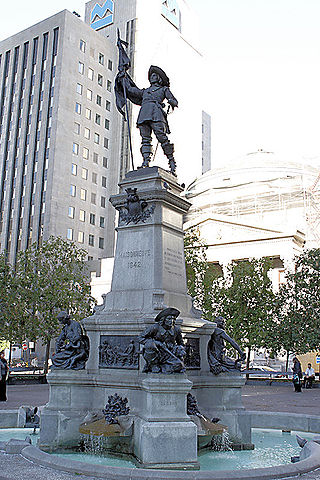
The Maisonneuve Monument is a monument by sculptor Louis-Philippe Hébert built in 1895 in Place d'Armes in Montreal.

The Notre-Dame Church was a church in Old Montreal that stood from 1682 until 1830. From 1821 to 1822, it served as the first cathedral of the Diocese of Montreal.
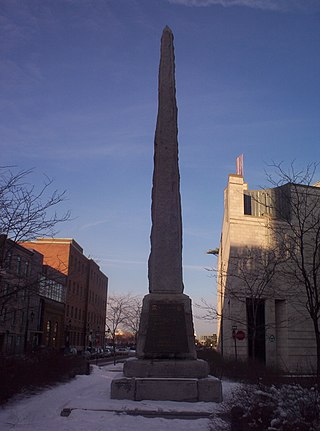
The Pioneers' Monument Obelisk is a monument in Old Montreal.
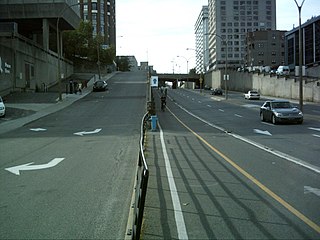
Berri Street is a major north–south street located in Montreal, Quebec, Canada. Berri Street links De la Commune Street in the south and Somerville Street in the north. The street is interrupted between Rosemont Boulevard and Jean Talon Street.

Louis-Philippe Hébert was a Canadian sculptor. He is considered one of the best sculptors of his generation.

